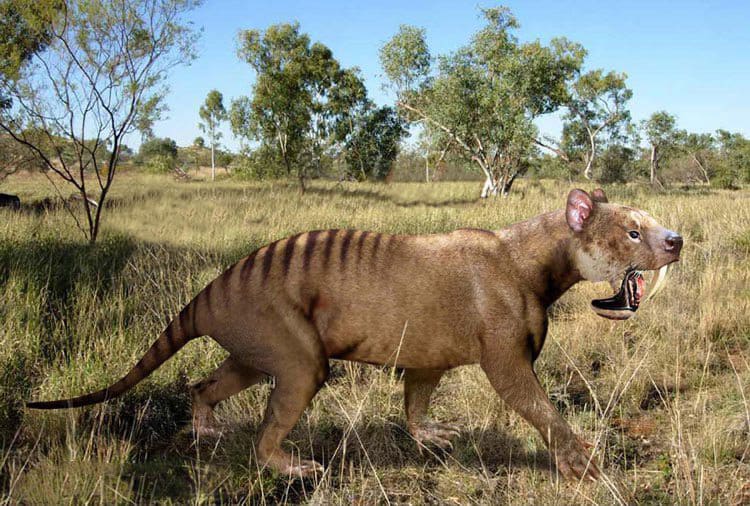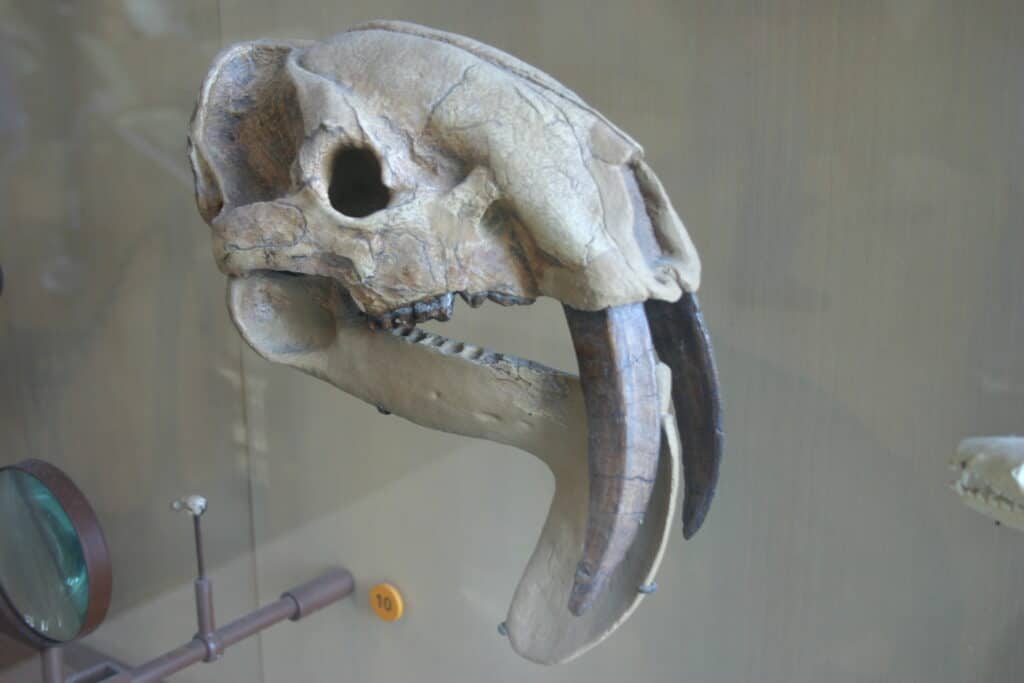The earth has hosted a variety of life through its billion of years of existence. Animals of the past tended to grow much larger than those of today. Luckily, not many giant predators walk the earth today, but we can still learn about the ones from the past using fossil evidence. Here you will discover the largest saber-toothed marsupial, which weighed nearly 300 lbs. Called the Thylacosmilus, this animal looked very similar to the saber-toothed cats but is actually more closely related to animals like kangaroos and wombats. Let’s look at the now-extinct ancient marsupial relative which lived between 3 to 10 million years ago.
Thylacosmilus: The Largest Saber Toothed Marsupial

The Thylacosmilus looked like the saber-toothed cat but was related to the marsupial.
©rom-diz/Publicdomain
The Thylacosmilus is an extinct genus that lived in South America during the Late Miocene, until the Pliocene epoch. While similar in appearance to the saber-toothed tiger, this species was not a cat at all. Thylacosmilus was a type of metatherian mammal that belonged to the order of Sparassodonta.
They are distant relatives to marsupials like kangaroos and wombats and were unique carnivorous animals of their time. Thylacosmilus had long sabers, but their jaws are much weaker than predator animals. Around the size of a leopard, this animal was large, and one of the only marsupial relatives with fang-like teeth.
Discovery of the Thylacosmilus
Thylacosmilus’ first discovery occurred in 1926 in Argentina. Their fossils were found during the Marshall Field Paleontological Expeditions in the Ituzaingo formation. At the time three specimens of this marsupial-like animal were discovered.
Paleontologist Elmer S. Riggs described this new genus as Thylacosmilus which means “pouch knife”. The two species of Thylacosmilus was named T.atrox and T. lentils. After its discovery, more fossils of this species were found spread across Argentina.
When discovered, Thylacosmilus was compared with the Smilodon since they both possessed saber teeth, and had a similar appearance. The saber teeth of Thylacosmilus are not fully exposed outside of its mouth and were hidden by a bony protrusion, Their canines also rested in different regions than the saber cat. The differences in teeth between Smilodon indicated that this saber-toothed marsupial relative used its teeth differently than the predatory ambushing animal.
Smilodon and Thylacosmilus are an example of convergent evolution, where animals evolve to look similar. Examples of modern convergent evolution include bats and birds, as well as dolphins and sharks.
The Saber Teeth and Appearance of Thylacosmilus

The Thylacosmilus’ canines looked like that of the saber-tooth cat.
©Ideonexus/CCBYSA2.0 – License
The large saber teeth of the Thylacosmilus are this animal’s most identifying trait, but they could not be seen since they were hidden within the flanges on their lower jaw. Walking on all fours, it is estimated this species weighed between 180 to 260 lbs. Some estimates have the Thylacosmilus weighing up to 330 lbs.
While no complete fossil has been discovered the missing skeletal parts are based on other members within the Sparassodonta order. This species’ length is estimated to be about 4 feet, and they had a medium-sized tail.
Thylacosmilus Diet
Thylacosmilus are carnivorous and are one of the largest meat-eating metatherians. Despite their fearsome look and large size, it is estimated that Thylacosmilus had a bite force around the same strength as a housecat. This animal used its strong front legs to hold onto prey, and killed by using their strong neck and saber teeth.
The wear marks found on fossilized teeth of the Thylacosmilus suggested they had a diet of very soft meat and did not eat bones. Newer studies also think this animal may not have been a dangerous predator at all, but a scavenger. Threats that this species faced in the wild included animals like the Terror Bird.
Habitat and Time Period of Thylacosmilus
South America during the Late Miocene to the Pliocene epoch is where the Thylacosmilus lived. The Thylacosmilus is thought to have lived in forests and savanna habitats. They avoided open plains since those regions had more aggressive competition and were filled with lots of predators.
This large saber-toothed marsupial relative died off after the land connection in North and South America during the middle of the Pliocene epoch. It was first believed that the Thylacosmilus went extinct since they were out-competed by a similar animal, Smilodon, but these two species have a separation of around 1.5 million years. The Thylacosmilus lived a very different life from Smilodon, even though they looked very similar.
Up Next:
Love ancient animals, check out these other great articles on the site that showcase now-extinct animals that lived thousands of years ago:
- Meet the Huge Ancient Turtles That Used To Roam Earth
- Discover A Massive Eagle That’s 3X the Size of a Bald Eagle
- This Ancient Mongolian Predator Was As Tall As A Horse And Weighed A Ton
- Discover 8 Incredible Animals That Used To Be Giant
The photo featured at the top of this post is © Gastón Cuello/CC BY-SA 3.0 – License / Original
Sources
- Dueling Sabers , Available here: https://www.fieldmuseum.org/blog/dueling-sabers-what-marsupial-has-common-cat#:~:text=Thylacosmilus%20was%20a%20saber%2Dtoothed,and%20three%20million%20years%20ago.
- Thylacosmilus , Available here: https://en.wikipedia.org/wiki/Thylacosmilus
- Thylacosmilus , Available here: https://www.britannica.com/animal/Thylacosmilus
Thank you for reading! Have some feedback for us? Contact the AZ Animals editorial team.







